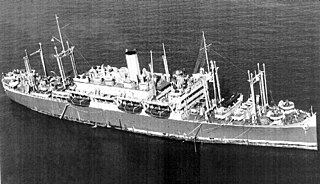
SS President Cleveland was originally built as Golden State for the United States Shipping Board (USSB), one of the planned World War I troop transports converted before construction into passenger and cargo vessels launched as Emergency Fleet Corporation Design 1029 ships first known, along with the smaller Design 1095 versions, in the trade as "State" ships due to names assigned for the nicknames of states and later as "535s" for their length overall. Almost all ships of both designs were renamed for United States presidents by May 1921, with Golden State being renamed President Cleveland. As one of the USSB-owned ships operated by agents of the board, President Cleveland was allocated to and operated by the Pacific Mail Steamship Company until sold by the USSB to the Dollar Steamship Line in 1925. After the demise of that line and creation of a new, replacement line, American President Lines, the ship remained with that line until government acquisition for the Second World War.

USS Leonard Wood (APA-12) was built by Bethlehem Shipbuilding Corporation and launched 17 September 1921 at Sparrows Point, Maryland as Nutmeg State, an Emergency Fleet Corporation Design 1029 ship intended as a World War I troop transport, but redesigned upon the armistice as a passenger and cargo ship and completed as Western World for delivery to the United States Shipping Board. The ship's acceptance on 5 May 1922 and delivery on 9 May 1922 marked the completion of the wartime shipbuilding program of the Emergency Fleet Corporation and the Shipping Board.

The SS Empire Miniver was a British steam merchant ship. She was originally an American merchant, launched in 1918 as SS West Cobalt. During a brief stint in the United States Navy in 1919, she was known as USS West Cobalt (ID-3836).
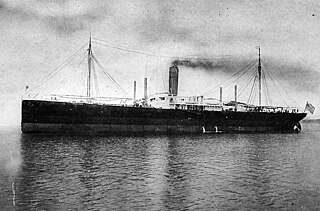
SS Dakotan was a cargo ship built in 1912 for the American-Hawaiian Steamship Company that served as a transport ship in the United States Army Transport Service in World War I, and then was transferred to the Soviet Union under Lend-Lease in World War II before being finally scrapped in 1969. During World War I, she was taken over by the United States Army as USAT Dakotan. Near the end of that war she was transferred to the United States Navy and commissioned as USS Dakotan (ID-3882). During World War II, the ship was transferred to the Soviet Union and renamed SS Zyrianin.
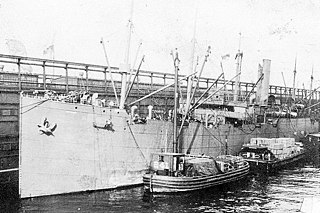
USS Artemis (ID-2187), also known as the USAT Artemis, was a German passenger liner seized by U.S. Customs at New York City at the start of American involvement in World War I. She was built in 1902 as Iowa and was renamed Bohemia in 1912. She served the United States Army as the transport USAT Artemis, and, at war’s end, she was transferred to the United States Navy as a transport for returning American troops and military equipment from Europe.

SS El Occidente was a cargo ship for the Morgan Line, a subsidiary of the Southern Pacific Company. During World War I, she was known as USAT El Occidente in service with the United States Army and as USS El Occidente (ID-3307) in service with the United States Navy. At the end of war, she reverted to her original name of SS El Occidente.

SS Point Bonita was constructed in 1918 and launched 27 March 1918 after a hull being built for foreign owners at Albina Engine and Machine Works was requisitioned during World War I by the United States Shipping Board (USSB). The ship saw service as the Navy transport USS Point Bonita, assigned Identification Number 3496, from 7 October 1918 to 7 April 1919, was returned to the USSB and saw civilian service with several commercial companies as San Pedro and Oliver Olson before again seeing service in World War II as USS Camanga (AG-42). After return to commercial service as Oliver Olson the ship was wrecked at the entrance to Bandon harbor in Oregon.
USS Besboro (AG-66) was built as Caddopeak, a United States Shipping Board (USSB) Emergency Fleet Corporation Design 1049 cargo ship built by Albina Engine & Machine Works, launched 18 October 1918. From 1922 Caddopeak served several commercial shipping companies until sold in 1937 to Burns Steamship Company and renamed Lurline Burns. On 2 February 1942 the ship was delivered to the War Shipping Administration, allocated to the United States Army and operated by Burns and Alaska Steamship Company under an Army charter agreement.

SS Pennsylvanian was a cargo ship built in 1913 for the American-Hawaiian Steamship Company. During World War I she was requisitioned by the United States Navy and commissioned as USS Pennsylvanian (ID-3511) in September 1918, and renamed two months later to USS Scranton. After her naval service, her original name of Pennsylvanian was restored.

SS Montanan was a cargo ship built in 1912 for the American-Hawaiian Steamship Company. During World War I service for the United States Army Transport Service, she was known as USAT Montanan. Montanan was built by the Maryland Steel Company as one of eight sister ships for the American-Hawaiian Steamship Company, and was employed in inter-coastal service via the Isthmus of Tehuantepec and the Panama Canal after it opened.

USS West Alsek (ID-3119) was a cargo ship in the United States Navy during World War I. She had been built as SS West Alsek for the United States Shipping Board (USSB) as part of the West boats, cargo ships built on the West Coast of the United States. She sailed on two voyages for the U.S. Navy before she was decommissioned after the Armistice.
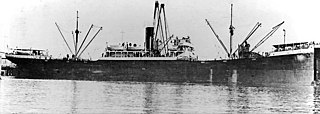
USS West Carnifax (ID-3812) was a cargo ship in the United States Navy shortly after World War I. After she was decommissioned from the Navy, the ship was known as SS West Carnifax, SS Exford, and SS Pan Royal in civilian service under American registry.

Seisho Maru was a cargo ship for Mitsui Bussan Kaisho in military service that was sunk by an American submarine during World War II. The ship had been built as SS West Caruth, a cargo ship for the United States Shipping Board (USSB) shortly after the end of World War I. Shortly after completion, the ship was inspected by the United States Navy for possible use as USS West Caruth (ID-2850) but was neither taken into the Navy nor ever commissioned under that name. Before being sold to Japanese owners in 1928, she was also known as SS Exmoor and SS Antonio Tripcovich.
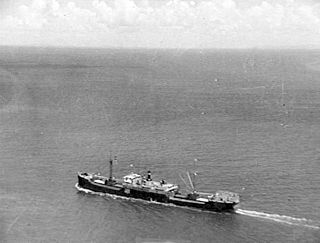
MS West Honaker was a diesel-powered cargo ship of the United States Maritime Commission (USMC) that was part of the "Corncob Fleet" of old ships sunk as part of the "gooseberry" breakwater off Utah Beach during the Normandy invasion. The ship was originally built as SS West Honaker, a steam-powered cargo ship built for the United States Shipping Board (USSB), a predecessor of the USMC. At the time of her completion in 1920, the ship was inspected by the United States Navy for possible use as USS West Honaker (ID-4455) but was neither taken into the Navy nor ever commissioned under that name.

SS Empire Simba was a British steam-powered cargo ship. She was originally an American ship, launched in 1918 as SS West Cohas. During a stint in the United States Navy from 1918 to 1919, she was called USS West Cohas (ID-3253).
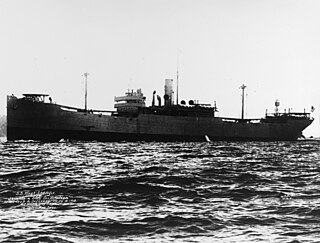
USS West Lianga (ID-2758) was a cargo ship for the United States Navy during World War I. She was later known as SS Helen Whittier and SS Kalani in civilian service under American registry, as SS Empire Cheetah under British registry, and as SS Hobbema under Dutch registry.

USS West Ekonk (ID-3313) was a cargo ship for the United States Navy during World War I. She was later known as SS West Ekonk in civilian service under American registry, and as SS Empire Wildebeeste under British registry.

USS West Haven (ID-2159) was a steel–hulled freighter that saw service with the U.S. Navy during World War I, and which later saw convoy service during the Battle of the Atlantic in World War II.
SS Empire Chamois was a 5,864 GRT cargo ship which was built in 1918 by Ames Shipbuilding and Drydock Co, Seattle. She was ordered by the Compagnie Générale Transatlantique but was requisitioned by the United States Navy and commissioned as USS West Mount with the pennant number ID-3202 in 1918. She was decommissioned in May 1919 and passed to the United States Shipping Board (USSB) as SS Westmount. In 1927 she was sold to the Dimon Steamship Corporation and renamed SS Pacific Redwood. She returned to the USSB in 1932 and passed to the United States Maritime Commission (USMC) in 1937. In 1940, she was passed to the Ministry of Shipping, passing to the Ministry of War Transport in 1941 and being renamed SS Empire Chamois. She was sold to Astral Shipping Co Ltd in 1946 and renamed SS Granview. In 1949 she was sold to the Compagnia Maritime del Este, Panama and renamed SS Chamois, serving until 1958 when she was scrapped. She was the last Ames-built ship afloat.
Portmar was a United States-flagged merchant vessel that was constructed in response to World War I, operated by a succession of companies in the interwar period, then taken up for wartime shipping in World War II.


















